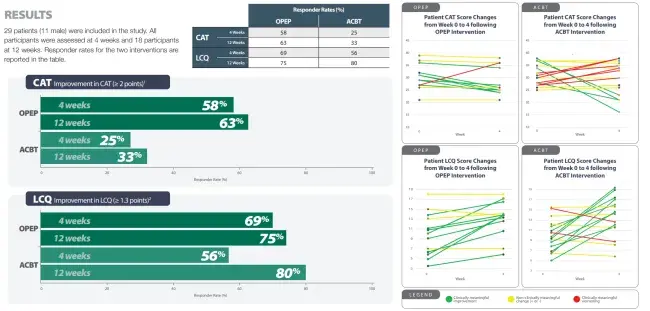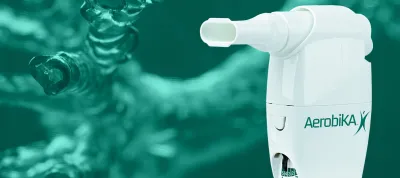RATIONALE
Despite multiple drug treatment options available, many people with COPD still suffer from poor quality of life, often as a result of excess mucus. This is further exaggerated as a result of exacerbations. This study assessed people with COPD suffering with mucus hypersecretion, post exacerbation in Wales, UK, following treatment with a handheld, OPEP device or the ACBT breathing technique.
METHODS
Inclusion criteria:
• People with COPD aged 40-90 years old
• Chronic Bronchitis (CB) phenotype
• Gold E
• FEV1 / FVC <0.70
• >10 pack year history
• Regular sputum producers
• >15 CAT
• On guideline pharmacological therapy
• Exacerbation treated with antibiotics or steroids
Exclusion criteria:
• Patients with life expectancy < 12 months
• Unstable cardiac conditions
• OPEP contraindications
All standard of care COPD therapy was maintained during the study. Participants were randomized to either OPEP (Aerobika* OPEP, Trudell Medical International) or ACBT, with LCQ and CAT data collected at 0, 4, and 12 weeks. Responder rates - % of patients having MCID (minimum clinically important difference) improvement - were assessed for each.
RESULTS

CONCLUSIONS
For COPD patients being discharged from hospital following exacerbation, the first 30 days recovery period is critical. Both interventions were associated with clinically important improvements in cough and quality of life for a number of patients, with OPEP having responder rates of 69% (LCQ) and 58% (CAT) respectively and ACBT 56% and 25%. Such improvements were generally maintained or improved further after 12 weeks. Notwithstanding the relatively small sample size, the results of this study provide evidence to support the potential use of the interventions in CB COPD patients.
